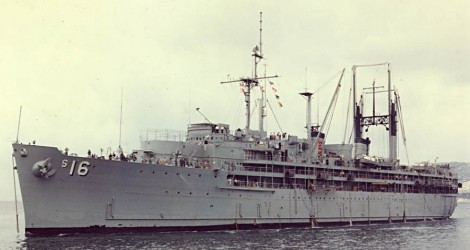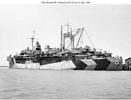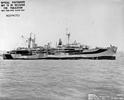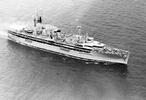

 |
Search the Site with

|
 |  |
USS HOWARD W. GILMORE was the fourth FULTON - class submarine tender. Laid down as NEPTUNE, the ship was renamed HOWARD W. GILMORE while still under construction to honor Commander Howard W. Gilmore. Decommissioned on September 30, 1980, the GILMORE was subsequently laid up in the James River, Fort Eustis, Va. On February 10, 2006, she was sold for scrapping to Bay Bridge Enterpises of Chesapeake, Va.
| General Characteristics: | Launched: September 16, 1943 |
| Commissioned: May 24, 1944 | |
| Decommissioned: September 30, 1980 | |
| Builder: Mare Island Naval Shipyard, Vallejo, Calif. | |
| Propulsion System: Diesel electric | |
| Propellers: two | |
| Length: 529.5 feet (161.4 meters) | |
| Beam: 73 feet (22.3 meters) | |
| Draft: 25.6 feet (7.8 meters) | |
| Displacement: approx. 18,000 tons | |
| Speed: 15 knots | |
| Armament: four 20mm guns (in 1980) | |
| Crew: approx. 1200 |
Crew List:
This section contains the names of sailors who served aboard USS HOWARD W. GILMORE. It is no official listing but contains the names of sailors who submitted their information.
USS HOWARD W. GILMORE Cruise Books:
About the Ship's Name:
Howard Walter Gilmore was born in Selma, Ala., 29 September 1902 and enlisted in the Navy 15 November 1920. In 1922 he was appointed to the Naval Academy and after commissioning in 1926 reported to battleship MISSISSIPPI. Gilmore underwent submarine training in 1930 and in the years that followed served in various submarines and at stations ashore. In 1941 he assumed his first command, SHARK, only to be transferred the day following Pearl Harbor to take command of the still-unfinished GROWLER. Gilmore commanded his submarine skillfully during three Pacific war patrols, receiving the Navy Cross for an attack on enemy destroyers during the first and a gold star in lieu of a second Navy Cross for the second. The submarine continued to take a heavy toll of shipping on her fourth war patrol, and on the night of 6-7 February 1943 she approached a convoy stealthily for a surface attack. Suddenly a fast gunboat closed and prepared to ram. Commander Gilmore skillfully outmaneuvered his opponent and rammed him at 17 knots, seriously damaging GROWLER. What followed is perhaps most eloquently expressed in the official citation: "In the terrific fire of the sinking gunboat's heavy machine guns, Commander Gilmore calmly gave the order to clear the bridge, and refusing safety for himself, remained on deck while his men preceded him below. Struck down by the fusillade of bullets and having done his utmost against the enemy, in his final living moments Commander Gilmore gave his last order to the Officer of the Deck, 'Take her down!' The submarine dived; damaged but under control, she was brought safely to port by her well-trained crew inspired by the courageous fighting spirit of their captain." Commander Gilmore received the Medal of Honor posthumously, and his inspiring words and courageous sacrifice have taken their place among the great traditions of the US Navy.
USS HOWARD W. GILMORE History:
The GILMORE was launched at Mare Island Naval Shipyard on 16 September 1943 with CDR Gilmore's widow as sponsor, and commissioned on 14 May 1944. Captain Daniel N. Cone, USN, of San Francisco, California, was her first Commanding Officer.
After two months of shakedown cruise and post-shakedown repair, the GILMORE got underway for Pearl Harbor, Hawaii. Arriving on 15 August 1944 she began serving the Submarine Force, Pacific Fleet. Within a month she set sail again, this time to the Majuro Atoll, Marshall Islands, to tend submarines and train ship and squadron relief crews. Five months later, the GILMORE got underway to Pearl Harbor, arriving on 19 January 1945. For 10 days stores and supplies were loaded aboard, as well as Submarine Division 301. On 23 February 1945 she arrived at Brisbane, Australia, discharged her passengers and got underway for Humboldt Bay, Dutch New Gulnea. She left Humboldt Bay the same day, after loading on supplies, and headed for Subic Bay, Philippines.
On 13 March 1945, GILMORE began setting up a Submarine Rest and Recuperation Camp in Subic Bay. This was done along With her normal duties of refitting submarines of the 7th Fleet.
The GILMORE was ordered back to the States on 31 August 1945, and she set sail for Pearl Harbor and then to San Diego. 600 passengers got off in San Diego and the GILMORE got underway again. This time for New York via the Panama Canal. On 17 October I945 the GILMORE and many other US Navy ships sailed through New York Harbor for President Harry S. Truman‘s Navy Day celebration.
Upon leaving New York, the GILMORE stayed briefly in New London, Conn., and Portsmouth, N.H., then headed for Key West, Florida, arriving on 15 January 1946. For the next 13 years the GILMORE tended submarines in the Atlantic Fleet, participated in Operation Springboard (a fleet exercise held in the Caribbean in 1958), and made journeys to Norfolk, Virginia, to tend submarines for short periods of time.
30 July 1959 saw the arrival of USS GILMORE to Charleston, South Carolina. For the next 18 months GILMORE tended submarines, rode out Hurricane Donna in September 1960, and operated off the Florida coast. She then entered the Charleston Naval Shipyard. There she underwent a Fleet Rehabilitation and Modernizations (FRAM) overhaul and conducted refresher training in the Caribbean before returning to her tender duties at Charleston. During 1962 the GILMORE crew worked around the clock to service two submarine squadrons because of the Cuban Missile Crisis, GILMORE stayed in Charleston until 1967.
In 1971 the GILMORE spent a short time in Key West, Florida. Then in June 1972, GILMORE went to the yards in Alabama and in August transferred to the yards in Mississippi. After her shipyard period, the GILMORE was ready to begin 1973 in Cuba, Haiti, Charleston, and Key West respectively. On 13 March 1973 the USS HOWARD W. GILMORE departed for La Maddalena, Sardinia, Italy.
The GILMORE arrived in La Maddalena, Sardinia, on 6 April 1973 after a port visit in Barcelona, Spain. She arrived with 10 families on board. The first submarine alongside was USS SKIPJACK on 16 April 1973. With her move to Italy, GILMORE became the first deployed attack submarine tender since World War II.
The submarine tender stayed in La Maddalena until 1980 when she returned to Norfolk, Va., for decommissioning. The HOWARD W. GILMORE was decommissioned on 30 September 1980. She remained mothballed until 2006 when she was sold for scrapping.
USS HOWARD W. GILMORE Image Gallery:
 |  |  |
 Back to Submarine Tenders list.
Back to Submarine Tenders list.  Back to Ships list.
Back to Ships list.  Back to selection page.
Back to selection page.  Back to 1st page.
Back to 1st page.